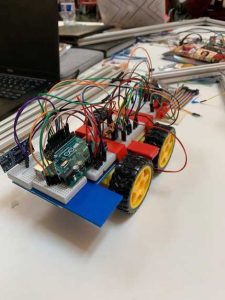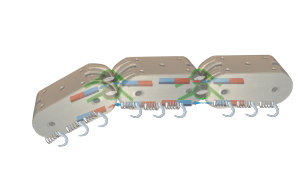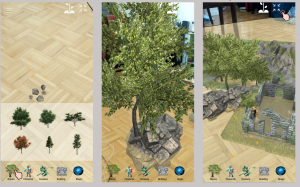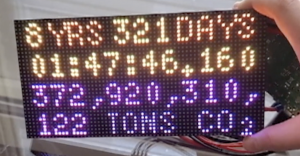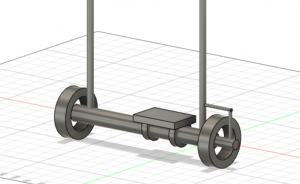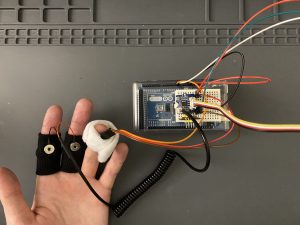On Thursday, April 30th awardees of the NYU Prototyping Fund gathered via Zoom to share updates on their projects and showcase what they built over the semester.
The Prototyping Fund is a collaborative program offered by the Design Lab @ NYU Tandon MakerSpace and the NYU Entrepreneurial Institute that awards teams of students up to $500 in the first round of funding and up to $2,000 in a second round to be used to build prototypes The program also connects them with the resources, tools, and mentors they need to bring their ideas to life.
During the showcase, participants from the Phase 1 and Phase 2 cohorts dialed-in from across the country to speak about their prototyping experiences and share feedback with each other. In the 7 years running this program, this was the first time we’ve hosted the event virtually. We loved seeing how the teams leveraged the new digital medium for their presentations. Some teams presented slides via screen-share, others brought their prototypes directly to their computer’s camera to show different angles, and others who did not have their prototypes easily accessible showed photographs taken earlier in the semester. Special guests joined from NYU Tandon faculty and our respective teams at the Design Lab and the NYU Entrepreneurial Institute to provide feedback.
Despite being remote, the showcase was extremely interactive and many participants and guests used Zoom’s chat feature to communicate in real time - asking questions and sharing resources. In the past, hosting the event IRL has prevented us from spending quality time with each team and also prohibited teams from connecting with each other (teams would stand at their booth for the duration of the event). We were impressed with each team’s flexibility and resilience in light of the circumstances. For example, a few teams decided to focus on doing more research on their potential users/customers as they could not work on their prototypes.
This has been an unprecedented semester to say the least. Some teams lost access to their labs, others returned to their hometowns and had to leave their prototypes in Brooklyn. We joked during the showcase that many teams are now in a “long-distance relationship” with their prototypes.
We are so impressed by what each team accomplished - many teams have chosen to continue their projects in the fall and will remain in the program. See updates from each team below, and find out how you can help them!
-Sarah Maibach and Anne-Laure Fayard
Prototyping Fund Phase 1 Team Updates:
AI League: AI League seeks to create a remote control car-based soccer game with on-board AI that have ball-detecting capability and strategy. Kids can play car-soccer against their friends or against self-contained AI enemies! Ajeet Gary, Tandon MS ‘21 & Yassin Chandran
How we build it: Our prototype uses a Raspberry Pi, H-Bridges, servo motors, a Lithium-ion battery, and ultrasonic sensors to create the car.
Top lesson learned: Kids toys need to be resilient and non-fragile
Top lesson learned: We are excited to see what people come up with for AI strategies - we plan to have an online, open-source bank of AI's that people can program, post, and download to their car! This lets you play against an AI constructed by someone anywhere in the world, and even pit multiple AI against each other. Particularly, if anyone has an idea for how machine learning could be used in a real-life setting like this, we would appreciate the input! Neither of us are ML experts, and would love a pointer in the right direction.
Ateles: Atéles is a compact surface conforming gripper that can be attached to various systems for sturdy anchoring. Its applications include aid in drone delivery, construction, rescue, and exploration. Estefano Calero, Tandon BS'21 ; Edgar Duran Garcia, Tandon BS'22 ; Steve Ucho, Tandon BS'21
How we build it: Atéles was designed for maximum efficiency and payload weight. Atéles is composed of a four fingered hand, each with three magnetically articulated segments packed with spring loaded hooks.
Top lesson learned: It is essential to understand the scope and time frame of your project. We started ateles because we knew it would be a challenge, we were prepared to overcome the hurdles from such a large project. Thinking about the big picture made it difficult to approach the start.
How can the NYU community help you moving forward?: NYU’s Makerspace and Leslie Elab will be tremendous resources in building our project. Additionally, speaking with professors with extensive experience in the robotics field will help us redefine our approach, and ultimately our product. We also believe that connections to field experts at our aimed clientele will provide great insight on the market needs.
-
brian: brian is a smart guitar with sound effects control integrated into the body of the instrument. Ariane Schoenwiesner, Tandon BS'21
How we build it: Most of the body is CNC milled wood, with an FPGA dev board as a controller inside to apply the effects.
Top lesson learned: Target audience should include students and less experienced players as well as live performers.
-
Cartographr: Cartographr combines procedural terrain generation technology with a custom map editing feature to help users create beautiful, realistic world maps and 3D terrain and landscapes to be projected onto a surface in real space.Joanna Liu, Steinhardt, MA'20, Charles Chan, Tandon, BS'21, Andrew Liang, Tandon, BS'22, Rivelle Levin, Steinhardt, MA'21, Roxy Ho, Steinhardt, MA'22
How we build it: We built the augmented reality drag and drop feature with Unity AR foundation with Google ARCore Cloud Anchor integration. We built the procedural landmass generation with perlin noise.
Top lesson learned: We have learned that even for a creative tool like ours, we still need to know who our first users are to be able to develop features for that specific group. It has been a difficult time for all team members to come together in unity to build something when the world changes drastically. However, as long as we have a unified goal, we can work through anything. This project has been a blessing for us to be together working toward something great.
How can the NYU community help you moving forward?: We have recently finished the Startup Bootcamp and will be joining the Startup Summer Sprint. We found the programs very beneficial for us to have a clearer goal for this project. We would hope to gather more people to test out our application for us to get more insights.
-
Climate Clock: The Climate Clock aims to use the power of metrics to instill both a fear and a hope for a future world affected by climate change. In the same way that COVID curves have highlighted the power of social distancing we want to give people understandable metrics (Time left till irreversible Climate Change / Average Global Temperature increases etc) to help them be more aware of the impact of climate change with the hope that we can create some action (campaigning to representatives on climate issues / reducing ones carbon footprint). Shlok Paul, CAS BS ‘20; Ariane Schoenwiesner, Tandon BA ‘20; Omar Gowayed, Tandon PhD ‘21; Ingrid Paredes, Tandon PhD ‘21
How we build it: Here's a link where the team has detailed how to build the clock. PS: I've rarely physically built things and I'll say it was wicked fun!
Top lesson learned: User engagement and social interactions are critical to the propagation of these clocks!
How can the NYU community help you moving forward?: There is work for everyone interested! We want to develop new metrics (it is a lot of data mining and statistics), we want to design better physical models (heyo all you makerspace kids!), we want to provide better visuals (anyone interested in for example: modeling carbon release via a number of trees graphic?) but most importantly we want a climate aware NYU community to talk to and better understand how we can build this signaling platform to increase the size of their communities <3.
-
GPStroller: A stroller attachment and connected smartphone app which allows parents to know exactly where their child is and has been walked that is easy to use, lightweight, does not require an external source of power, and readily available. Claire Velau, Tandon BS '20, Gabrielle Fisher, Tandon BS '20
How we build it: We built our hardware system using preexisting materials from SparkFun and Adafruit. The hardware we purchased is easily found online, but requires programming and additional pieces. For our software, we created various flowcharts to lay out the general functionality we were aiming for. We were planning on 3D printing the casing for the hardware to be attached to a stroller.
Top lesson learned: The top lesson we learned is that the beginning of the prototyping progress consists of a lot of trial and error. Parts of our prototype that we assumed would work easily actually required a lot of unexpected work. We had to work through various ideas and plans during the design and building portion of our prototype, but that is okay. Things change when you're creating a new product, but that is not a bad thing.
How can the NYU community help you moving forward?: Once we again have access to the MakerSpace, we will need to build and test the power generating wheel attachment, so anyone with mechanical engineering skills would be a benefit to our project. In addition, we would love to be able to more seamlessly integrate the code from the mobile application and that of the GPS hardware, so any advanced computer scientists would also be a great benefit.
-
Matrix: Matrix is building a B2B platform that gauges emotion response from audience during the test screening of the movie to help marketing departments within movie distribution companies to fine-tune their marketing campaigns.
Malika Baymuradova, Tandon BS’21, David Nakhapetian Tandon’21, Rafael Karapetyan, Columbia University ‘19
How we build it: We have tested different sensors for accuracy and tried to get data from PPG and GSR to see the patterns while watching a video.
Top lesson learned: Patience is the key. It took a lot of time for us to find the best sensors and it seemed like it is taking ages but then at the end of the day we made it and realized that it was a long process of learning which definitely pays of now.
How can the NYU community help you moving forward?: We hope to continue get advises on our strategy and prototype design building.
-
Repose: Repose is a posture health system that allows users to recognize the root cause of pain and targets the tension in their body when sitting or standing for long periods of time through a low-profile wearable and companion app. Runa Koli, Steinhardt Ph.D 2023, Matthew Stirling, Steinhardt MA 2021, Caroline
How we build it: We built an Arduino and EMG (Electromyography) based prototype that goes on the shoulders to read signals from the trapezius muscles and measure muscle tension.
Top lesson learned: Pack your prototype when going on spring break! Honestly though, the importance of getting something tangible in front of the team and being able to really walk through the process of finding what is working and what is not.
How can the NYU community help you moving forward?: We're doing a survey on work, seating positions, and muscle tension! Take a quick survey and let us know how posture and muscle tension affect your workday.
Prototyping Fund Phase 2 Teams Updates:
Walkway's generators could produce 200 kWh/day under subway turnstiles
Benjamin Zhu, CAS BA ’23 & Max Trop, Tandon BS ’23
How Picklock Found Their Enthusiasts
Mary Georgescu, Tisch MFA ‘20 & Connor Carson, Tisch MFA ‘20
From Industrial Sized Bioreactor to Microfluidic Chips with NYU iGEM
Ali Hasan, Tandon BS ‘20 and David Sung, Tandon BS ‘21




